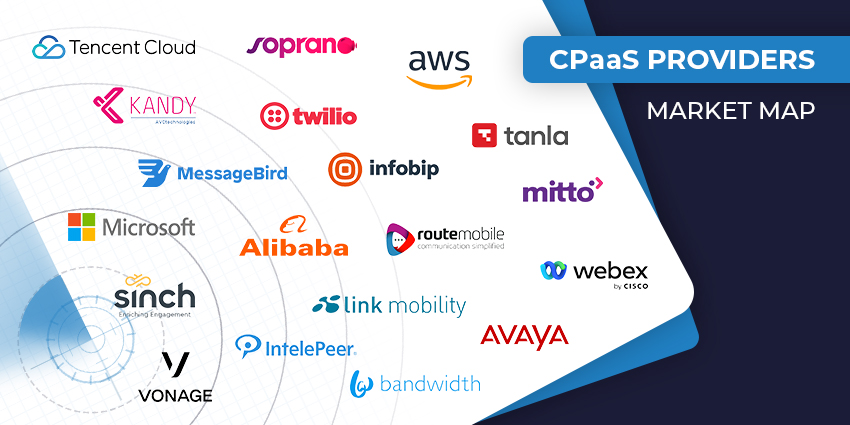CPaaS, or “Communications Platform as a Service” has introduced the world of communications and collaboration to a new era of flexibility. Companies of all sizes can use CPaaS to build crucial features for communication into the heart of their daily processes.
With CPaaS, organisations can access everything they need for an effective digital transformation, including presence tools, workflow management, and instant messaging, all through simple solutions like SDKs and APIs. For those who can’t afford to compromise with a one-size-fits-all communication stack, there are few things more effective than CPaaS. In fact, around 85% of companies say that using APIs will be critical to their growth going forward.
We caught up with some of the leaders in the CPaaS realm, including Alcatel-Lucent Enterprise, Ribbon, and Voximplant, to discuss where the industry is heading as we approach 2020.
What CPaaS Trends Helped to Shape 2019?
To gain a comprehensive view of the future, we often need to look at the past, and how certain trends have led us to the point that we’re at today. In 2019, the CPaaS industry grew drastically, accelerated by the growing demand for more flexible and custom communication stacks. We asked our Roundtable experts what they thought some of the leading trends were for 2019.
 Matteo Kotch, Cloud Business Development Manager of ALE:
Matteo Kotch, Cloud Business Development Manager of ALE:
The Cloud Business Development Manager for Alcatel Lucent Enterprise told us that one of the biggest trends for 2019 was the increasing demand for “hypermobility” and flexible working.
“Whether working remotely, on the go or simply using mobile devices (connected to public networks) in the workplace, companies realise that to be able to successfully attract and retain productive talent, they need to be flexible in the way that their employees work and from where”
According to Kotch, the rise of the Millennial workforce and generation Z means that flexibility will become increasingly crucial going forward. More businesses are beginning to use technology like ALE’s Rainbow UCaaS and CPaaS platforms to deliver contextual and collaborative communications to users wherever they are. Indeed, Timewise notes that 15.3% of job adverts now offer flexible working as an option. What’s more, Forbes found that 92% of millennials prioritise flexibility when job hunting.
Sacha Gera, SVP of Cloud Products Ribbon:
According to Ribbon, 2019 was a year of significant growth for the CPaaS environment. CPaaS saw a double-digit growth level in the second quarter of 2019 alone. As vendors continue to compete, many are adding new communication channels that combine messaging, voice, video and other channels with intelligent tools like AI and IoT.
“CPaaS adoption has expanded beyond the original adopters, on-demand companies such as Uber, to encompass companies in more ‘traditional’ areas including retail, banking, and health care where customer engagement and integration with business processes are critical.”
Ribbon believes that wrappers or pre-packaged applications will be useful to streamline the adoption of CPaaS, as well visual building and low-code tools. “We are also seeing advanced Communications Service Providers offer up marketplaces that offer their business customers new options for implementing real-time communications quickly and easily, driving new revenue streams.”
 Alexy Aylarov, CEO and Co-founder of Voximplant:
Alexy Aylarov, CEO and Co-founder of Voximplant:
Co-founder and CEO of Voximplant, Alexy Aylarov, noted that in 2019, carriers began to deliver more CPaaS platforms by working with CPaaS vendors that could provide white-label offerings.
“2020 will see additional carriers enter this market through partnerships as they will be able to share the risk while simultaneously rapidly launching CPaaS offerings to their customers”
“As the customer base broadens, we’ll see growth in the development of turnkey digital solutions helping to accelerate the integration of communications into a customer’s web site and mobile applications.”
Additional enhancements in the CPaaS environment are likely to emerge as artificial intelligence, natural language processing, transcription, and analytics pave the way for more immersive cloud-based solutions and services. “We also expect to see more of these solutions being developed for specific verticals, and additional integration between UCaaS and CPaaS solutions. This will ensure that existing communications solutions will be part of the business process integration introduced within the CPaaS platform.”
What Technologies are Creating the Biggest Opportunities?

Most of the communication and collaboration environment today is caught up in its own kind of digital transformation. The arrival of new innovations and technologies has changed the way that we approach CPaaS, with everything from new low-code APIs, to immersive app-building systems. We asked our roundtable contributors for their insights into the technologies that represent the biggest opportunities in CPaaS.
The Cloud Business Development Manager for ALE, Matteo Kotch, noted that to better engage with employees and customer and simplify daily processes, companies are looking at intelligent technology. Indeed, the demand for smart communication capabilities is growing for both staff and customers alike. Questions on how a business can benefit from things like IoT and AI are now emerging in the modern landscape.
“Inserting AI into a communication flow can help optimise customer engagement by promoting self-service and (at times) engaging a helpful human contact if the AI senses frustration or hesitation (Sentiment analysis) by the customer. Using AI enables the optimisation of agent resources while simultaneously addressing most routine interactions.”
Kotch noted that connecting objects and sensors into a process flow in the business landscape can stimulate better decision making and handling of emergency situations. According to DZone, IoT and AI together could promise a new future for communication and business processes.
Our thought leader from Ribbon, Sacha Gera, told us that as the adoption of CPaaS grows in the current landscape, it’s spawning a new “S-Curve” of innovation. This basically means that companies are looking for more straightforward ways to integrate communication channels into their business processes.
“Customers interacting with a business crave a seamless experience no matter where they initiate contact (social media, web page, email, text, voice, etc.,) or how many times they switch channels.”
Ribbon notes that contact centres are some of the biggest beneficiaries of CPaaS capabilities, as these flexible tools allow them to resolve problems more rapidly, While finding the right interaction for each customer. Any small or mid-sized business could potentially accomplish more with CPaaS, however.
“And to further enhance the customer experience, channels can be combined with predictive modeling and business processes to create customised interactions based on a customer’s products of interest, past buying/search habits, and personal information.”

The CEO and Co-Founder of Voximplant, Alexy, told us that there are a number of innovative technologies that are leading the way for a growing demand in the CPaaS environment. Voximplant can see a future for machine learning, artificial intelligence, and 5G in the modern marketplace, as well as AV1. According to Aylarov:
“These technologies are game changers for the communications industry that can change the market landscape in the near future.”
What Trends Will We See in 2020?
With 2020 just around the corner and the demand for CPaaS growing all the time, there’s a good chance that we’ll continue to see the environment developing as we move into the new year. Today’s companies demand more flexibility and customisation options for their communication and collaboration stacks.
We asked our thought leaders from the CPaaS environment to share their predictions on where the market is likely to go in the next year.
ALE and Matteo Kotch believe that integrating technologies like IoT and AI into business processes will be a crucial focus for leading companies going into 2020. One of the main enablers for accessing this kind of technology is a CPaaS solution. As more workloads move away from the traditional on-premises environment, businesses will start looking for vendors that offer solutions from a variety of cloud providers in a more diverse environment.
“Using a CPaaS platform such as Alcatel-Lucent Enterprise’s Rainbow enables businesses to integrate these disparate cloud-based applications and workloads, their remaining premise equipment (IoT and legacy) and applications, to optimize or create new workflows. Application developers and company DevOps can access libraries of APIs, SDKs and developer resources to add communication and collaboration capabilities to facilitate the interactions with customers and help automate certain processes.”
Kotch told us that according to IDC, the CPaaS market is set to grow from a value of only $2 billion in 2017, to an incredible $10.9 billion in 2022. The age of CPaaS is coming.

According to Ribbon, throughout 2019, carriers started rolling out new CPaaS options by partnering with vendors that could offer a broad selection of white-labelled solutions. As we move into 2020, there’s a good chance that additional carriers will move into the market through partnerships and collaboration. These partnerships will allow companies to share the risk while launching more rapid CPaaS innovations for customers.
“As the customer base broadens, we’ll see growth in the development of turnkey digital solutions helping to accelerate the integration of communications into a customer’s web site and mobile applications.”
Ribbon also believes that additional enhancements in the CPaaS space will come as artificial intelligence tools like transcription, analytics, voice recording, and natural language processing allow for the development of immersive cloud-based services and solutions.
“We also expect to see more of these solutions being developed for specific verticals, and additional integration between UCaaS and CPaaS solutions”
“This will ensure that existing communications solutions will be part of the business process integration introduced within the CPaaS platform.”
Voximplant’s CEO and co-founder, Alexy Aylarov told us that his team predicts a growth in the number of machine learning and artificial intelligence solutions coming into the communication environment. According to Aylarov, these innovations will also appear in the form of contact centre automation that improves customer service environments, and visual builders for CPaaS that support the no-code or low-code trend.
Alexy also said that going forward, he expects to see “CPaaS vendors offering CCaaS solutions similar to the offerings from Twilio Flex. This will allow for better growth and faster omni-channel expansion opportunities going forward.”







